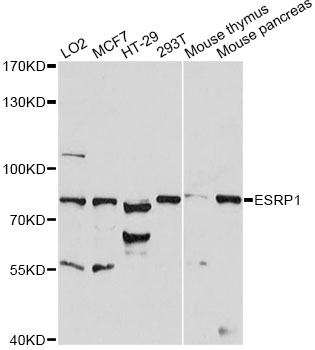-
Product Name
ESRP1 Polyclonal Antibody
- Documents
-
Description
Polyclonal antibody to ESRP1
-
Tested applications
WB
-
Species reactivity
Human, Mouse
-
Alternative names
ESRP1 antibody; RBM35A antibody; RMB35A antibody; epithelial splicing regulatory protein 1 antibody
-
Isotype
Rabbit IgG
-
Preparation
Antigen: Recombinant fusion protein containing a sequence corresponding to amino acids 1-220 of human ESRP1 (NP_060167.2).
-
Clonality
Polyclonal
-
Formulation
PBS with 0.02% sodium azide, 50% glycerol, pH7.3.
-
Storage instructions
Store at -20℃. Avoid freeze / thaw cycles.
-
Applications
WB 1:500 - 1:2000
-
Validations

Western blot - ESRP1 Polyclonal Antibody
Western blot analysis of extracts of various cell lines, using ESRP1 antibody at 1:1000 dilution.Secondary antibody: HRP Goat Anti-Rabbit IgG (H+L) at 1:10000 dilution.Lysates/proteins: 25ug per lane.Blocking buffer: 3% nonfat dry milk in TBST.Detection: ECL Basic Kit .Exposure time: 30s.
-
Background
mRNA splicing factor that regulates the formation of epithelial cell-specific isoforms. Specifically regulates the expression of FGFR2-IIIb, an epithelial cell-specific isoform of FGFR2. Also regulates the splicing of CD44, CTNND1, ENAH, 3 transcripts that undergo changes in splicing during the epithelial-to-mesenchymal transition (EMT). Acts by directly binding specific sequences in mRNAs. Binds the GU-rich sequence motifs in the ISE/ISS-3, a cis-element regulatory region present in the mRNA of FGFR2. Regulates splicing and expression of genes involved in inner ear development, auditory hair cell differentiation, and cell fate specification in the cochlear epithelium (By similarity).
Related Products / Services
Please note: All products are "FOR RESEARCH USE ONLY AND ARE NOT INTENDED FOR DIAGNOSTIC OR THERAPEUTIC USE"
